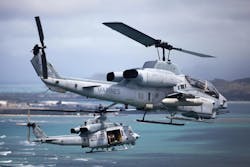Northrop Grumman to upgrade and support avionics for the AH-1Z and UH-1Y helicopters for U.S. Marine Corps
RIDGECREST, Calif. – U.S. Navy helicopter avionics experts are asking Northrop Grumman Corp. to upgrade and support H-1 integrated avionics systems for the U.S. Marine Corps AH-1Z Super Cobra and UH-1Y Super Huey attack and utility helicopters to enhance performance, commonality, reliability, and maintainability.
Officials of the Naval Air Warfare Center weapons Division at China Lake Naval Air Weapons Station in Ridgecrest, Calif., announced a $337.9 million five-year contract Friday to the Northrop Grumman Mission Systems segment in Woodland Hills, Calif., for H-1 avionics research and development.
The H-1 Upgrade program is replacing aging AH-1W and UH-1N helicopters with upgraded AH-1Z Super Cobra and UH-1Y Super Huey attack and utility helicopters to enhance commonality, reliability, and maintainability.
Northrop Grumman will develop and test H-1 integrated avionics systems, identify maintenance capabilities, upgrade test and measurement equipment for H-1 avionics, and will investigate new capabilities and anomalies related to H-1 avionics and weapons.
Related: Civilian and military aircraft get avionics upgrades
Northrop Grumman manufactures, upgrades, and support the Gen III mission computers that are the heart of the company's Integrated Avionics System (IAS) that powers the glass cockpit avionics of the UH-1Y and AH-1Z helicopters. Dual mission computers provide centralized control of the IAS and display situational awareness and health monitoring information.
The Northrop Grumman conduction-cooled Gen III Technical Refresh mission computer incorporates a ruggedized 6U VME PowerPC-based single board computer. Interfaces include Fast Ethernet, four serial ports, parallel I/O, and built-in-test. FlightPro has a standard partitioned real-time operating system called INTEGRITY-178 tuMP for multicore architectures from Green Hills Software in Santa Barbara, Calif., with ARINC 653 and POSIX support.
The IAS and mission computers can accommodate future system upgrades; rapid insertion of new technologies; and integration of other avionics, communications, and survivability equipment. Northrop Grumman also provides the operational flight program software that controls the IAS.
The mission computer's standard configuration also includes a quad channel 1553 mezzanine card, high-speed serial card, digital I/O module with eight channels of opto-coupled discrete inputs, eight channels of opto-coupled discrete outputs, and 16 channels of general-purpose bi-directional discretes that can be programmed individually as outputs or inputs.
Related: Elbit Systems wins $110M to upgrade M-17 military helicopter avionics
The FlightPro mission computer is capable of Required Navigation Performance/Area Navigation (RNP/RNAV) in all flight regimes, including departure, en route, terminal, and non-precision approach using GPS as the sole navigation source.
The flight computers use 28-volt DC or 115-volt AC three-phase 400 Hz input power, measure 13.61 by 11.5 by 7.55 inches, and weigh 30.4 pounds. The computers have rated 3,200 hours mean time between failures.
The flight computer software is RTCA DO-178C compliant, has ARINC-653 partitioning for safety and security, and complies with the Modular Open Systems Architecture (MOSA) standard. The software is aligned with the Future Airborne Capability Environment (FACE) technical standard, has hardware-independent application software developed to MIL-STD-498, under MIL-STD-882C safety program environmental qualification.
On this contract Northrop Grumman will do the work in Woodland Hills, Calif., and at other U.S. locations, and should be finished by June 2027. For more information contact Northrop Grumman Mission Systems online at www.northropgrumman.com, or Naval Air Systems Command at www.navair.navy.mil.

John Keller | Editor-in-Chief
John Keller is the Editor-in-Chief, Military & Aerospace Electronics Magazine--provides extensive coverage and analysis of enabling electronics and optoelectronic technologies in military, space and commercial aviation applications. John has been a member of the Military & Aerospace Electronics staff since 1989 and chief editor since 1995.

